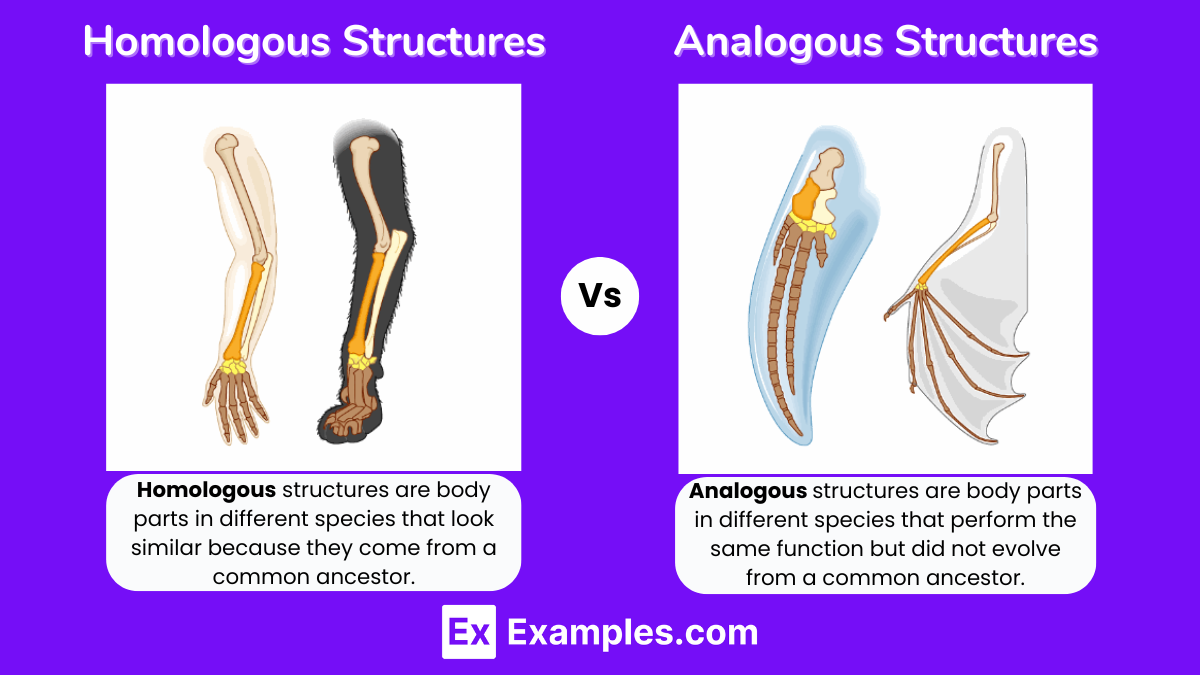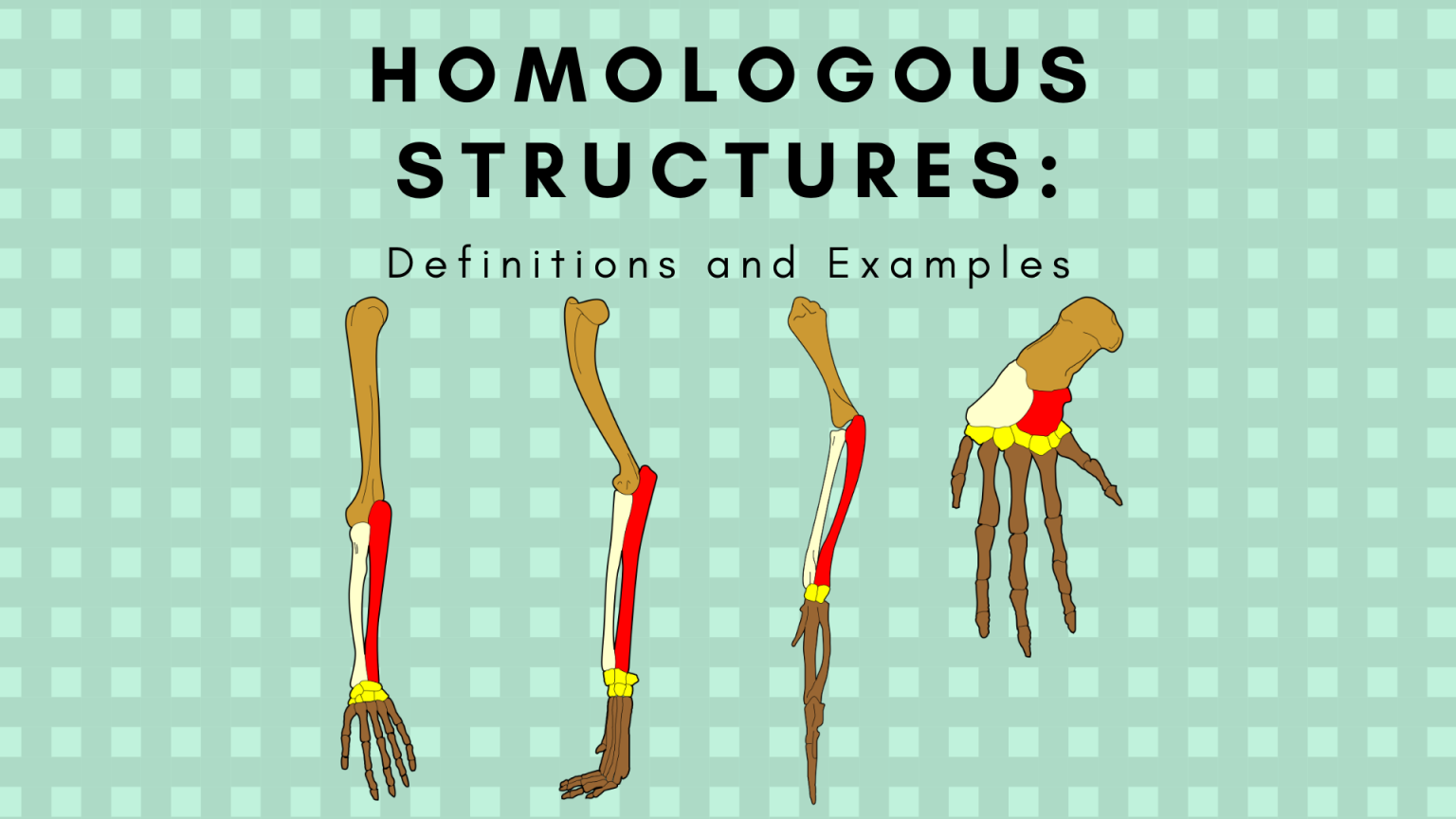Some Examples Of Homologous Structures: Unlocking The Secrets Of Evolution
So listen up, folks. If you've ever wondered how different species can share similar body parts despite looking totally different, you're about to dive into the fascinating world of homologous structures. These structures are like nature's way of saying, "Hey, we might look different on the outside, but deep down, we're all connected." This concept is super important in understanding evolution, and we're gonna break it down for you in a way that's easy to grasp. So grab your favorite drink, and let's get started.
Homologous structures are kinda like family heirlooms passed down through generations, but instead of jewelry or antique furniture, we're talking about bones, limbs, and even DNA. These structures show up in different species, proving that they share a common ancestor way back in the evolutionary timeline. It's like finding a long-lost cousin at a family reunion – surprising but totally cool.
Now, if you're thinking this sounds a bit sciency and complicated, don't worry. We're here to simplify it for you. By the end of this article, you'll not only understand what homologous structures are but also why they matter so much in the grand scheme of life. And trust me, it's gonna be a wild ride. So, let's jump right in!
Read also:Block 16 Urban Food Hall A Culinary Paradise In The Heart Of The City
What Are Homologous Structures Anyway?
Alright, let's start with the basics. Homologous structures are parts of different organisms that share a similar structure or origin but may serve different functions. Think of it like this: you and your cousin might both have the same nose shape, but one of you uses it for smelling flowers while the other uses it to detect the freshest pizza in the room. Same structure, different purpose.
These structures provide evidence of shared ancestry, which is a big deal in the world of biology. They show that even though species might look and behave differently, they all come from the same family tree. And no, we're not talking about the oak tree in your backyard – we're talking about the tree of life!
Why Do Homologous Structures Matter?
Here's the thing: homologous structures aren't just random quirks of nature. They're crucial pieces of evidence in the study of evolution. By comparing these structures across different species, scientists can piece together the evolutionary relationships between them. It's like being a detective, except instead of solving crimes, you're solving the mysteries of life.
Plus, understanding homologous structures helps us appreciate the diversity of life on Earth. It shows us that despite our differences, we're all connected in some way. And who doesn't love a good story about connection and unity?
Some Examples of Homologous Structures
Now that we've got the basics down, let's dive into some examples. These examples are gonna blow your mind – trust me. They're like the hidden gems of the natural world, waiting to be discovered.
1. The Limbs of Tetrapods
One of the most famous examples of homologous structures is the limbs of tetrapods. These are animals with four limbs, like humans, birds, and reptiles. Even though these animals use their limbs for different things – walking, flying, swimming, or climbing – their limb structures are surprisingly similar. It's like nature's way of saying, "Why reinvent the wheel when you can just tweak it a little?"
Read also:Who Is Luke Wilsons Girlfriend In 2025 Everything You Need To Know
2. The Wings of Birds and Bats
Now, here's where things get interesting. Birds and bats both have wings, but they're not related in the same way as, say, humans and chimps. However, their wings share a similar structure, indicating that they evolved from a common ancestor. It's like two different branches of the family tree coming up with the same brilliant idea.
3. The Flippers of Dolphins and Sharks
Alright, let's talk about water creatures. Dolphins and sharks both have flippers, but they're not even closely related. Yet, their flippers share a similar structure, which suggests that they evolved to adapt to their aquatic environment. It's like nature's version of convergent evolution – two totally different species coming up with the same solution to the same problem.
How Do Scientists Identify Homologous Structures?
So, how do scientists figure out which structures are homologous and which ones aren't? It's not as simple as looking at two animals and saying, "Hey, they kinda look the same." Scientists use a combination of methods, including comparative anatomy, molecular biology, and even fossils, to identify these structures.
For example, they might compare the bone structure of two different species to see if they share similarities. Or they might analyze DNA sequences to find genetic links. It's like putting together a giant puzzle, except the pieces are scattered across millions of years of evolution.
Homologous Structures vs. Analogous Structures
Now, here's where things can get a little tricky. Homologous structures are different from analogous structures, and it's important to know the difference. Homologous structures share a common origin, while analogous structures have similar functions but different origins. It's like comparing cousins and strangers – one has a family connection, while the other just happens to look alike.
For instance, the wings of birds and bats are homologous, but the wings of birds and insects are analogous. Both sets of wings allow flight, but they evolved independently in different lineages. It's like two different inventors coming up with similar gadgets to solve the same problem.
Fun Facts About Homologous Structures
Here are a few fun facts to keep in mind:
- Humans and whales share a common ancestor, which is why we both have similar bone structures in our limbs.
- The human appendix is considered a vestigial organ, which means it used to serve a purpose in our ancestors but no longer does.
- Even plants have homologous structures, like leaves and stems, which evolved to perform different functions.
Homologous Structures in Everyday Life
You might be wondering how all this talk about homologous structures applies to everyday life. Well, it turns out that understanding these structures can help us in a bunch of ways. For starters, it can inform medical research by helping scientists understand how different species respond to diseases or treatments. It can also guide conservation efforts by showing us which species are most closely related and therefore most in need of protection.
Plus, it's just plain cool to know that you share a common ancestor with a dolphin or a bat. It's like having a secret handshake with the entire animal kingdom.
Challenges in Studying Homologous Structures
Of course, studying homologous structures isn't all sunshine and rainbows. There are challenges involved, like incomplete fossil records and the complexity of genetic data. But scientists are up to the task, using advanced technologies like DNA sequencing and 3D imaging to uncover the mysteries of evolution.
It's like being a detective in a world where the evidence keeps changing. But hey, that's what makes it exciting, right?
Conclusion: The Big Picture
So there you have it, folks. Homologous structures are more than just cool science facts – they're a key to understanding the interconnectedness of all life on Earth. By studying these structures, we can unlock the secrets of evolution and gain a deeper appreciation for the diversity of life around us.
Now it's your turn. Leave a comment below and let us know what you think. Did you learn something new? Do you have any questions? And don't forget to share this article with your friends – knowledge is power, after all. Until next time, keep exploring and stay curious!
Table of Contents
- What Are Homologous Structures Anyway?
- Why Do Homologous Structures Matter?
- Some Examples of Homologous Structures
- How Do Scientists Identify Homologous Structures?
- Homologous Structures vs. Analogous Structures
- Fun Facts About Homologous Structures
- Homologous Structures in Everyday Life
- Challenges in Studying Homologous Structures
- Conclusion: The Big Picture


